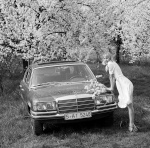1908 Benz 150 hp Racing Car
Portal Mercedes-Benz Brasil :: Guia de Modelos Mercedes-Benz Clássicos - Área técnica :: Outros modelos clássicos :: Outros modelos clássicos
Página 1 de 1 • Compartilhe
 1908 Benz 150 hp Racing Car
1908 Benz 150 hp Racing Car
[Tens de ter uma conta e sessão iniciada para poderes visualizar esta imagem]
(from DaimlerChrysler Press Release) Held on a road circuit near Dieppe, the French Grand Prix was considered to be the European motor sport event just after the turn of the century. Which is why, in 1908, Benz engineers Hans Nibel and Louis de Groulart, a Belgian, constructed three Grand Prix cars specially for this race under the supervision of Georg Diehl. Driven by Victor Héméry, René Hanriot and Fritz Erle, they took places two, three and seven, beaten only by Christian Lautenschlager in a Mercedes. Benz was incidentally the only team to have all its entrants complete the course.
Technically speaking, the 1908 Benz Grand Prix car corresponds to the racing car standard of the first decade of the century: 4-cylinder engine with siamesed cylinder pairs, V-valves, twin ignition. The maximum bore permitted by the regulations for the French Grand Prix (155 mm) was used to the full, which, combined with the extremely long stroke of 200 mm, gives more than 15 litres swept volume. The leaf-sprung rigid axles are suspended on a pressed-steel sectional frame. The braking system consists of foot-controlled outside band brakes that operate on the transmission shafts and hand-controlled drum brakes in the drive-chain sprockets. The front wheels have no brakes.
1909/10 the Grand Prix car incidentally formed the basis for the legendary „Blitzen Benz" - the then fastest land vehicle in the world.
Facts and Figures
Engine: water-cooled straight four with siamesed cylinder pairs, overhead valves, Benz updraught carburettor, magneto ignition system with two spark plugs per combustion chamber.
Bore x stroke: 154.9 x 200 mm.
Capacity: 15,095 cm³.
Output: 116 kW (158 hp) at 1,500 rpm.
Transmission system: 4-speed gearbox.
Length/Width/Height: 4,015/1,400/1,465 mm.
Tare weight: 1,200 kg.
Maximum speed: 162,9 km/h.*
*with Grand Prix step-up ratio; with the longest step-up ratio at the Daytona record week in 1909: 183.4 km/h.
(from DaimlerChrysler Press Release) Held on a road circuit near Dieppe, the French Grand Prix was considered to be the European motor sport event just after the turn of the century. Which is why, in 1908, Benz engineers Hans Nibel and Louis de Groulart, a Belgian, constructed three Grand Prix cars specially for this race under the supervision of Georg Diehl. Driven by Victor Héméry, René Hanriot and Fritz Erle, they took places two, three and seven, beaten only by Christian Lautenschlager in a Mercedes. Benz was incidentally the only team to have all its entrants complete the course.
Technically speaking, the 1908 Benz Grand Prix car corresponds to the racing car standard of the first decade of the century: 4-cylinder engine with siamesed cylinder pairs, V-valves, twin ignition. The maximum bore permitted by the regulations for the French Grand Prix (155 mm) was used to the full, which, combined with the extremely long stroke of 200 mm, gives more than 15 litres swept volume. The leaf-sprung rigid axles are suspended on a pressed-steel sectional frame. The braking system consists of foot-controlled outside band brakes that operate on the transmission shafts and hand-controlled drum brakes in the drive-chain sprockets. The front wheels have no brakes.
1909/10 the Grand Prix car incidentally formed the basis for the legendary „Blitzen Benz" - the then fastest land vehicle in the world.
Facts and Figures
Engine: water-cooled straight four with siamesed cylinder pairs, overhead valves, Benz updraught carburettor, magneto ignition system with two spark plugs per combustion chamber.
Bore x stroke: 154.9 x 200 mm.
Capacity: 15,095 cm³.
Output: 116 kW (158 hp) at 1,500 rpm.
Transmission system: 4-speed gearbox.
Length/Width/Height: 4,015/1,400/1,465 mm.
Tare weight: 1,200 kg.
Maximum speed: 162,9 km/h.*
*with Grand Prix step-up ratio; with the longest step-up ratio at the Daytona record week in 1909: 183.4 km/h.

Daniel AMG- Cadastro desatualizado pendente regularização
- Número de mensagens : 2671
Data de inscrição : 19/10/2007
Interesses : mercedes benz
Sexo : País :
País : 
Estado :
Advertências :
 Tópicos semelhantes
Tópicos semelhantes» Mercedes-Benz apresenta CLA45 AMG Racing Series no Brasil
» 1922 Mercedes Racing Special
» Mercedes 140 HP Grand Prix - 1908
» W201 - Racing Era
» C63 Black X RS6 drag racing
» 1922 Mercedes Racing Special
» Mercedes 140 HP Grand Prix - 1908
» W201 - Racing Era
» C63 Black X RS6 drag racing
Portal Mercedes-Benz Brasil :: Guia de Modelos Mercedes-Benz Clássicos - Área técnica :: Outros modelos clássicos :: Outros modelos clássicos
Página 1 de 1
Permissões neste sub-fórum
Não podes responder a tópicos




